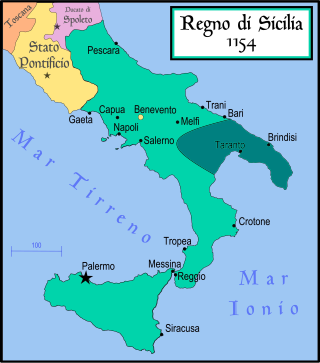
Roger II was King of Sicily and Africa, son of Roger I of Sicily and successor to his brother Simon. He began his rule as Count of Sicily in 1105, became Duke of Apulia and Calabria in 1127, then King of Sicily in 1130 and King of Africa in 1148. By the time of his death at the age of 58, Roger had succeeded in uniting all the Norman conquests in Italy into one kingdom with a strong centralized government.
William I, called the Bad or the Wicked, was the second king of Sicily, ruling from his father's death in 1154 to his own in 1166. He was the fourth son of Roger II and Elvira of Castile.

William II, called the Good, was king of Sicily from 1166 to 1189. From surviving sources William's character is indistinct. Lacking in military enterprise, secluded and pleasure-loving, he seldom emerged from his palace life at Palermo. Yet his reign is marked by an ambitious foreign policy and a vigorous diplomacy. Champion of the papacy and in secret league with the Lombard cities, he was able to defy the common enemy, Frederick Barbarossa. In the Divine Comedy, Dante places William II in Paradise. He is also referred to in Boccaccio's Decameron.
Tancred or Tankred is a masculine given name of Germanic origin that comes from thank- (thought) and -rath (counsel), meaning "well-thought advice". It was used in the High Middle Ages mainly by the Normans and especially associated with the Hauteville family in Italy. It is rare today as a first name, but still common as a Norman surname: Tanqueray, Tanquerey, Tanqueret. Its Italian form is Tancredi and in Latin it is Tancredus. Its Italian patronymic is also Tancredi.

Roger III, of the House of Hauteville, was the eldest son and heir of King Tancred of Sicily and Queen Sibylla. He was made Duke of Apulia, probably in 1189, shortly after his father's accession. In the summer of 1192 he was crowned co-king with his father. Follari were minted at Messina bearing both Tancred and Roger's names as kings.

The Principality of Taranto was a state in southern Italy created in 1088 for Bohemond I, eldest son of Robert Guiscard, as part of the peace between him and his younger brother Roger Borsa after a dispute over the succession to the Duchy of Apulia.

Robert II was the count of Aversa and the prince of Capua from 1127 until his death.

Alfonso, also called Anfuso or Anfusus (c. 1120 – 10 October 1144), was the Prince of Capua from 1135 and Duke of Naples from 1139. He was an Italian-born Norman of the noble Hauteville family. After 1130, when his father Roger became King of Sicily, he was the third in line to the throne; second in line after the death of an older brother in 1138. He was the first Hauteville prince of Capua after his father conquered the principality from the rival Norman Drengot family. He was also the first Norman duke of Naples after the duchy fell vacant on the death of the last Greek duke. He also expanded his family's power northwards, claiming lands also claimed by the Papacy, although he was technically a vassal of the Pope for his principality of Capua.
Grimoald Alferanites was the prince of Bari from 1121 to 1132.
Ranulf II was the count of Alife and Caiazzo, and duke of Apulia. He was a member of the Italo-Norman Drengot family which dominated the Principality of Capua for most of the century between 1050 and 1150. Ranulf's wife, Matilda, was the sister of King Roger II of Sicily.
Roger III was the eldest son of King Roger II of Sicily and Elvira of Castile. He was the Duke of Apulia from 1134 until his death.

Elvira of Castile was a member of the House of Jiménez and the first Queen of Sicily as the wife of Roger II of Sicily.
Alexander was the second count of Conversano (1085–1132), the son and successor of Geoffrey the Elder.
Tancred of Conversano, the youngest son of Geoffrey, Count of Conversano, became the count of Brindisi on his father's death in 1100.
Robert I of Bassunvilla was a Norman baron from Molise. His family originated in Vassonville, near Dieppe.

The Hauteville was a Norman family originally of seigneurial rank from the Cotentin. The Hautevilles rose to prominence through their part in the Norman conquest of southern Italy. By 1130, one of their members, Roger II, was made the first King of Sicily. His male-line descendants ruled Sicily until 1194. Some Italian Hautevilles took part in the First Crusade and the founding of the Principality of Antioch (1098).
Richard III, also known as Richard of Caleno, was the Norman count of Carinola and last quasi-independent Duke of Gaeta, ruling from 1121 to his death. From 1113, he was regent of Gaeta for his cousin or nephew, Duke Jonathan; in 1121 he succeeded him. As duke he was a nominal vassal of the Princes of Capua, to whom he was related.
The Treaty of Mignano of 1139 was the treaty which ended more than a decade of constant war in the Italian Mezzogiorno following the union of the mainland duchy of Apulia and Calabria with the County of Sicily in 1127.

The Norman conquest of southern Italy lasted from 999 to 1139, involving many battles and independent conquerors.

The trifollaro or trifollaris was a copper coin minted in southern Italy under the Normans. It was worth 120 nummi or 3 folles. The name trifollaro, used by scholars, was coined by the Italian numismatist Rodolfo Spahr. Contemporary sources do not use the name. Spahr interpreted the phrase tres follares aereos romesinam unam appretiatos in Falco of Benevento's discussion of the currency reform of 1140 as a reference to a new denomination of coin.